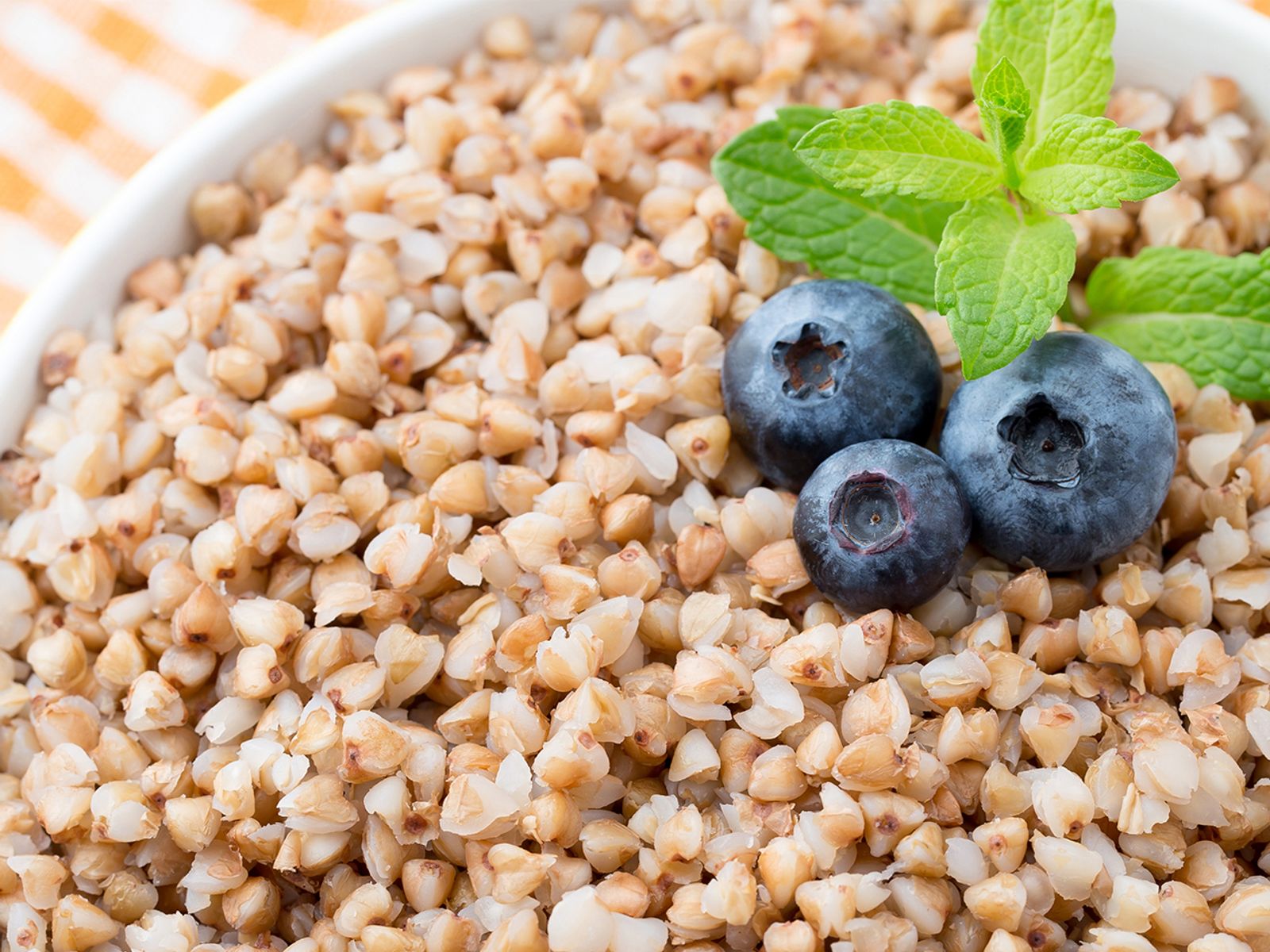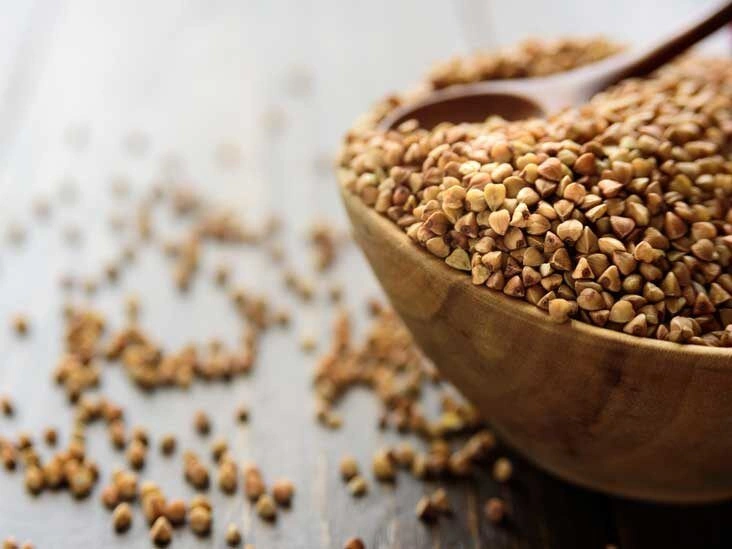Buckwheat provides a notable amount of fiber and several plant compounds with antioxidant activity, which may support cardiovascular health and help regulate blood sugar. It can, however, trigger allergic reactions in some individuals.
Buckwheat is classified among foods often called pseudocereals.
Pseudocereals are seeds eaten like cereal grains but that do not develop on grasses. Other familiar pseudocereals include quinoa and amaranth.
Despite its name, buckwheat is unrelated to wheat and is therefore naturally gluten-free.
It’s consumed as buckwheat tea or processed into groats, flour, and noodles. The groats — used similarly to rice — are a staple in many traditional European and Asian cuisines.

Buckwheat has gained popularity as a health food because of its high mineral content and antioxidants. Its advantages may include better blood sugar management.
Two main species grown for food are common buckwheat (Fagopyrum esculentum) and Tartary buckwheat (Fagopyrum tartaricum).
Major production occurs in the Northern Hemisphere, particularly in Russia, Kazakhstan, China, and parts of Central and Eastern Europe.
This article covers the essential facts about buckwheat.
Nutrition facts
Carbohydrates make up the bulk of buckwheat’s composition. It also supplies protein, various minerals, and antioxidant compounds.
The nutrient profile of buckwheat is significantly higher than that of many conventional grains. Nutritional values for 3.5 ounces (100 grams) of raw buckwheat are:
- Calories: 343
- Water: 10%
- Protein: 13.3 grams
- Carbs: 71.5 grams
- Sugar: 0 grams
- Fiber: 10 grams
- Fat: 3.4 grams
Carbs
Buckwheat is predominantly carbohydrate-based; carbs account for roughly 20% of boiled groats by weight (2).
These carbohydrates largely exist as starch, which is the principal storage form of carbs in plants.
Buckwheat ranks low to medium on the glycemic index (GI) — a gauge of how quickly a food elevates blood sugar after eating — and typically doesn’t provoke sharp blood sugar spikes (3).
Some soluble carbohydrates in buckwheat, such as fagopyritol and D-chiro-inositol, have been shown to help temper the post-meal rise in blood sugar (, 5).
Fiber
Buckwheat contains a fair amount of fiber, which the human body cannot digest. This nutrient supports colon health.
By weight, fiber constitutes about 2.7% of boiled groats and is mainly composed of cellulose and lignin (2).
Fiber is concentrated in the husk that surrounds the groat. Dark buckwheat flour retains this husk, giving it a distinctive taste (5, ).
The husk also contains resistant starch, a form of carbohydrate that resists digestion and is thus classified as fiber (, 7).
Resistant starch is fermented by beneficial gut microbes in the colon, which produce short-chain fatty acids (SCFAs) like butyrate.
Butyrate and other SCFAs nourish the cells lining the colon, enhancing gut health and potentially lowering colon cancer risk.
Protein
Buckwheat supplies modest amounts of protein.
Protein makes up about 3.4% of boiled buckwheat groats by weight (2).
The protein in buckwheat is high quality due to a well-balanced amino acid profile and is particularly rich in lysine and arginine (12).
Nevertheless, digestibility of these proteins is somewhat reduced by antinutrients such as protease inhibitors and tannins (5, ).
In animal studies, buckwheat protein has been effective at lowering blood cholesterol, inhibiting gallstone formation, and reducing colon cancer risk (, 14, , , ).
As with other pseudocereals, buckwheat is gluten-free and therefore appropriate for those with gluten sensitivity.
SUMMARYBuckwheat is mainly carbohydrate. It also provides a meaningful amount of fiber and resistant starch, which can benefit colon health, and small quantities of high-quality protein.
Vitamins and minerals
Buckwheat contains more minerals than many common cereals like rice, wheat, and corn (5).
However, it’s not especially rich in vitamins.
Between the two primary varieties, Tartary buckwheat typically has a higher nutrient density than common buckwheat (18).
The most plentiful minerals in common buckwheat include (, ):
- Manganese. Abundant in whole grains, manganese supports metabolism, growth, development, and antioxidant defenses.
- Copper. Often underconsumed in Western diets, copper is a vital trace element that may aid heart health in modest amounts.
- Magnesium. Adequate dietary magnesium is linked to lower risk of chronic conditions like type 2 diabetes and heart disease.
- Iron. Insufficient iron leads to anemia, which impairs the blood’s oxygen-carrying capacity.
- Phosphorus. This mineral is crucial for growth and the maintenance of tissues.
Compared with other grains, minerals in cooked buckwheat groats are particularly bioavailable.
This improved absorption is partly due to buckwheat’s relatively low phytic acid content, a common inhibitor of mineral uptake found in many seeds and grains.
SUMMARYBuckwheat is richer in minerals than many other cereals and pseudocereals. It’s especially high in manganese, copper, and magnesium, though it contains few vitamins.
Other plant compounds
Buckwheat is abundant in various antioxidant phytochemicals that account for many of its health-promoting effects. It supplies more antioxidants than several common cereal grains such as barley, oats, wheat, and rye (21, , ).
Tartary buckwheat usually contains more antioxidants than common buckwheat.
Some of buckwheat’s principal plant compounds include (, , 27, , , , , , ):
- Rutin. The primary antioxidant polyphenol in buckwheat, rutin may lower cancer risk and improve inflammation, blood pressure, and lipid levels.
- Quercetin. A common plant antioxidant, quercetin may provide several health benefits, including reduced risk of cancer and heart disease.
- Vitexin. Animal data suggest vitexin may offer various health effects; however, excessive consumption could contribute to thyroid enlargement.
- D-chiro-inositol. This unique soluble carbohydrate can lower blood sugar and may aid diabetes management. Buckwheat is the richest food source of D-chiro-inositol.
SUMMARYBuckwheat contains more antioxidants than many typical cereal grains. Key phytochemicals include rutin, quercetin, vitexin, and D-chiro-inositol.
Health benefits of buckwheat
As with other whole-grain pseudocereals, buckwheat is associated with a variety of health advantages.
Improved blood sugar control
Chronically elevated blood sugar can contribute to conditions like type 2 diabetes.
Therefore, blunting the post-meal increase in blood sugar is important for long-term health.
Because it’s a good fiber source, buckwheat has a low-to-medium GI and is generally safe for most people with type 2 diabetes (3).
Research links buckwheat consumption with reduced blood sugar in diabetic individuals.
In a diabetic rat study, a buckwheat concentrate lowered blood glucose by 12–19%.
This effect is largely attributed to D-chiro-inositol, which appears to increase insulin sensitivity, helping cells take up sugar from the bloodstream.
Additionally, certain buckwheat compounds may slow or inhibit the digestion of table sugar.
Collectively, these traits make buckwheat a beneficial option for people with type 2 diabetes or those aiming to better manage blood sugar.
Heart health
Buckwheat may also support cardiovascular health.
It contains several heart-supportive nutrients, including rutin, magnesium, copper, fiber, and particular proteins.
Among grains and pseudocereals, buckwheat is the richest source of rutin, an antioxidant with multiple potential benefits (39).
Rutin may reduce heart disease risk by inhibiting blood clot formation and lowering inflammation and blood pressure (27, , ).
Buckwheat has also been shown to improve blood lipid profiles. Unfavorable lipid profiles are a known risk factor for cardiovascular disease.
A study of 850 Chinese adults associated buckwheat intake with reduced blood pressure and improved lipid markers, including lower LDL (bad) cholesterol and higher HDL (good) cholesterol.
This benefit is thought to come from a type of protein that binds cholesterol in the digestive tract, reducing its absorption into the bloodstream (14, , , ).
SUMMARYBuckwheat may help control blood sugar, making it a smart choice for people with type 2 diabetes. It may also enhance heart health by improving blood pressure and lipid profiles.
Potential downsides
Besides potential allergic reactions in susceptible individuals, buckwheat has no widely known adverse effects when consumed in reasonable amounts.
Buckwheat allergy
An allergy to buckwheat is more likely in people who eat it frequently and in large quantities.
Allergic cross-reactivity can make this allergy more common in those already allergic to substances like latex or rice.
Symptoms can include skin rashes, swelling, gastrointestinal upset, and — in rare severe cases — anaphylaxis.
SUMMARYBuckwheat is not associated with many negative health effects, although some people may experience allergic reactions.
The bottom line
Buckwheat is a pseudocereal — a grain-like seed that doesn’t grow on grasses but is used like other cereals.
It’s gluten-free, a good source of fiber, and rich in minerals and various phytochemicals, particularly rutin.
Due to these properties, eating buckwheat is linked to several health benefits, including better blood sugar regulation and improved heart health.


















Leave a Reply
You must be logged in to post a comment.